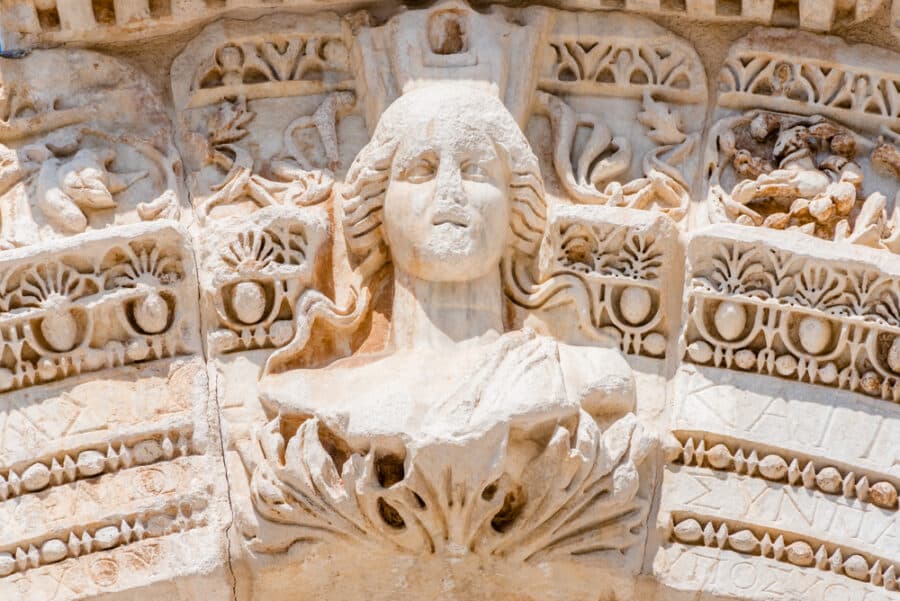Are you looking for a list of the top landmarks in Turkey? You’ve found it!
Turkey isn’t just a feast for the eyes with its diverse landscapes, ranging from the captivating Turkish Riviera to its rugged mountains; it’s a journey through history and culture. Imagine walking through ancient ruins, admiring grand Ottoman architecture, and soaking in vibrant local life – it’s all here in Türkiye.
But there’s more to this place than just good looks. It’s the perfect blend of history, culture, and nature. From the historical grandeur of Ephesus to the surreal terraces of Pamukkale, every corner of Turkey tells a story. And let’s not skip the food – it’s as rich and diverse as the country itself!
Turkey is a treasure trove of experiences waiting to be discovered, making it more than just a holiday spot – it’s a place of many experiences. Ready to dive into this mesmerizing land? Let’s go!
Skip Ahead To My Advice Here!
Famous Landmarks In Turkey
- Ancient City Of Hierapolis
- Ancient Tombs of Dalyan
- Ani Ruins
- Anıtkabir, Ankara
- Aspendos
- Basilica Cistern
- Blue Lagoon, Ölüdeniz
- Blue Mosque – Sultan Ahmed Mosque
- Bosphorus Strait
- Burning Flames of Chimaera
- Butterfly Valley
- Canakkale
- Carian Rock Tombs of The Dalyan Delta
- Cappadocia
- Chora Church (Kariye Museum)
- Dolmabahçe Palace
- Ancient City of Ephesus
- Galata Tower
- Gaziantep
- Grand Bazaar, Istanbul
- Hagia Sophia Grand Mosque
- Hattusha
- House of the Virgin Mary
- Kaputas Beach
- Lake Van
- Manavgant Waterfalls
- Mevlana Mausoleum, Konya
- Mount Nemrut, Adiyaman
- Mount Tahtali
- Myra Ruins
- Pamukkale
- Ruins of Aphrodisias
- Ruins of the Mausoleum of Halicarnassus
- Saklikent Canyon
- Selimiye Mosque, Edirne
- Sumela Monastery
- The City of Troy
- The Walls of Constantinople
- Topkapı Palace
Here are the most famous landmarks in Turkey we love:
Natural Landmarks In Turkey
1. Pamukkale & The White Travertine Pools

Pamukkale is a small spa town in Turkey’s Cappadocia region, known for its hot springs. The town is located at an altitude of 1,300 meters (4,265 feet) above sea level and has been on the UNESCO World Heritage list since 1986.
Pamukkale’s thermal waters were discovered in the early 20th century by locals who used them as natural spa treatments during their winter months. They date to around the 2nd century BC when Roman Emperor Trajan invaded Cappadocia from Syria with an army of 800000 men—the largest amphibious assault on record!
Today, you’ll find dozens of hotels along the shoreline where you can soak up some sun or enjoy some fresh air while enjoying some local cuisine at one of many restaurants that serve up dishes made from ingredients grown locally: beans & rice, apricots & walnuts; tomatoes & peppers!
Also known as the Cotton Castle, this is one of Turkey’s popular landmarks, so I recommend you go in low season.
2. Fairy Chimneys Of Cappadocia & Other Cappadocia Impressive Landmarks
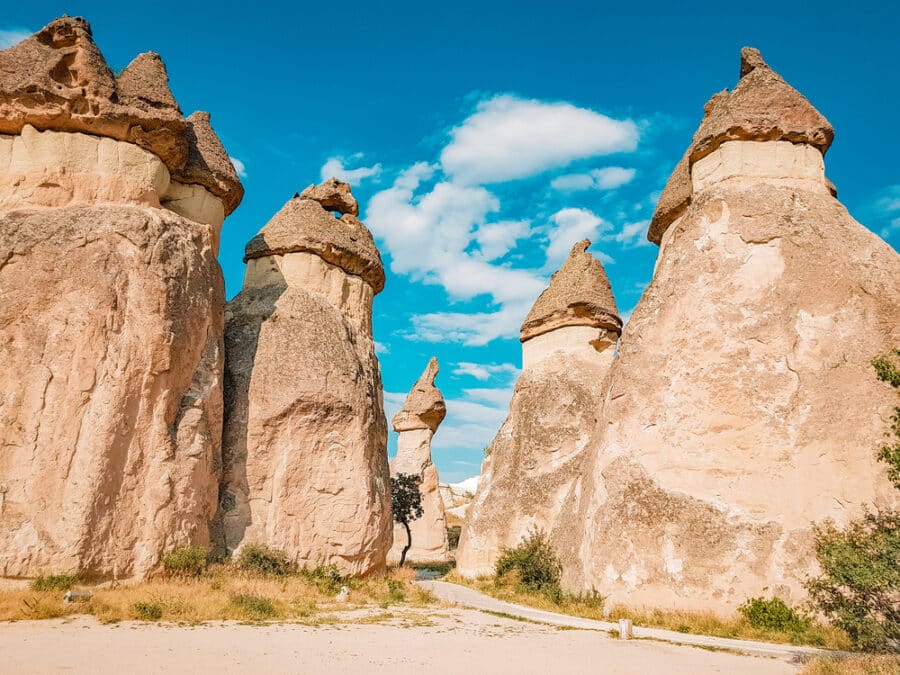
Cappadocia is a historical region of central Turkey, it’s famous for its unique geological formations and cave houses. The area has been inhabited since the Bronze Age when people started living in underground cities as they did not have enough space to build above ground. Oh, and of course, famed thanks to the scenic hot air balloon ride.
Goreme National Park
Those interested in Turkish nature may want to visit Goreme National Park in the Cappadocia area. This open-air museum is home to several rock-cut churches and monasteries that date back to the Byzantine era.
The top landmarks in Cappadocia are:
- Fairy Chimneys of Cappadocia
- Cave Houses of Goreme
- Uchisar Castle
- Derinkuyu Underground City
- Selime Monastery
- Zelve Open Air Museum
3. Lake Van
Lake Van is not just a lake; it’s Turkey’s largest, sitting in the far east of the country. Famous for its stunning azure waters and the Akdamar Island with its ancient Armenian church, it’s a serene getaway. You can get to Lake Van by plane to Van Airport, then a short drive to the lake.
4. Manavgant Waterfalls, Antalya
Hidden in Antalya, Manavgant Waterfalls are a natural wonder, where you can enjoy the soothing sound of water and lush greenery. It’s a refreshing escape from the city’s bustle. A bus ride or a drive from Antalya city center will take you there.
5. Blue Lagoon, Oludeniz

The Blue Lagoon in Ölüdeniz is a slice of paradise with its crystal-clear waters and stunning backdrop. It’s a hotspot for paragliding and swimming. To get there, you can take a bus or drive from Fethiye.
6. Butterfly Valley
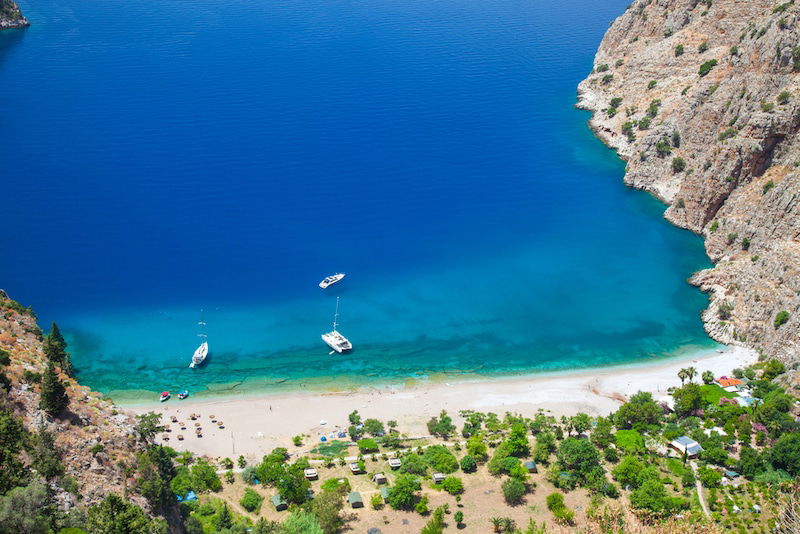
Butterfly Valley, near Fethiye, is a secluded natural beauty accessible only by boat or hiking. Known for its diverse butterfly species, it’s a perfect spot for nature lovers. Boats frequently depart from Ölüdeniz to the valley.
7. Burning Flames of Chimaera
The Chimaera, located in Cirali, is a fascinating natural phenomenon where flames mysteriously burn from the rocks. It’s a surreal sight, especially at night. You can reach Cirali by bus from Antalya, then it’s a short hike to the flames.
8. Mount Tahtali
Mount Tahtali, near Kemer in Antalya, offers breathtaking views of the coastline from its summit. The cable car ride to the top is an adventure in itself. It’s accessible from Kemer or Antalya by car or local transport.
9. Kaputas Beach
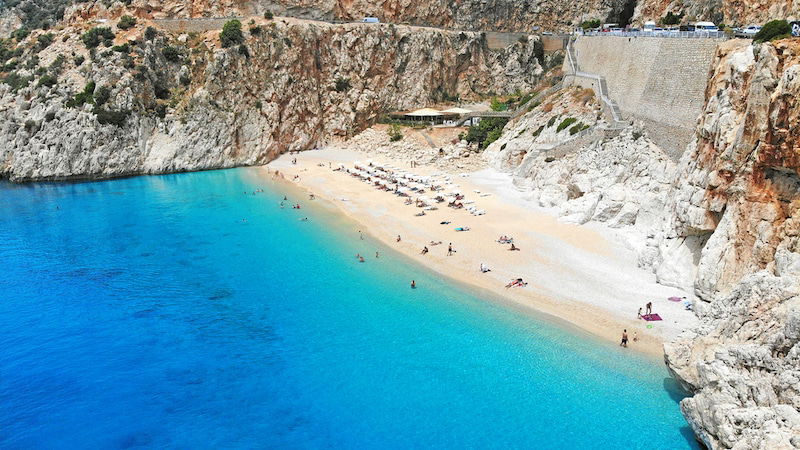
Kaputas Beach, located between Kaş and Kalkan, is a stunning cove known for its turquoise waters. It’s a bit of a climb down the stairs but totally worth it. You can get there by bus or car from either Kaş or Kalkan.
10. Saklikent Canyon
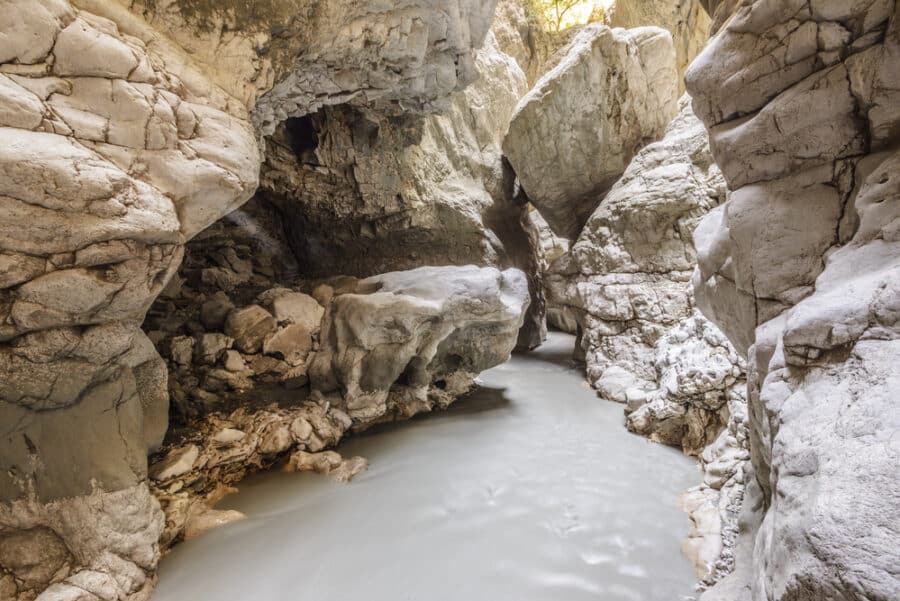
Saklikent Canyon, near Fethiye, is one of Europe’s longest canyons. It’s a fantastic place for hiking and cooling off in the stream. You can take a bus or a guided tour from Fethiye to reach this natural wonder.
11. Bosphorus Strait

The Bosphorus Strait is not just a body of water; it’s the lifeline of Istanbul, dividing Europe and Asia. A ferry ride across the Bosphorus is a quintessential Istanbul experience, offering stunning views of the city. Ferries depart from various points like Eminönü and Beşiktaş.
Cultural & Historical Places In Turkey
12. Basilica Cistern
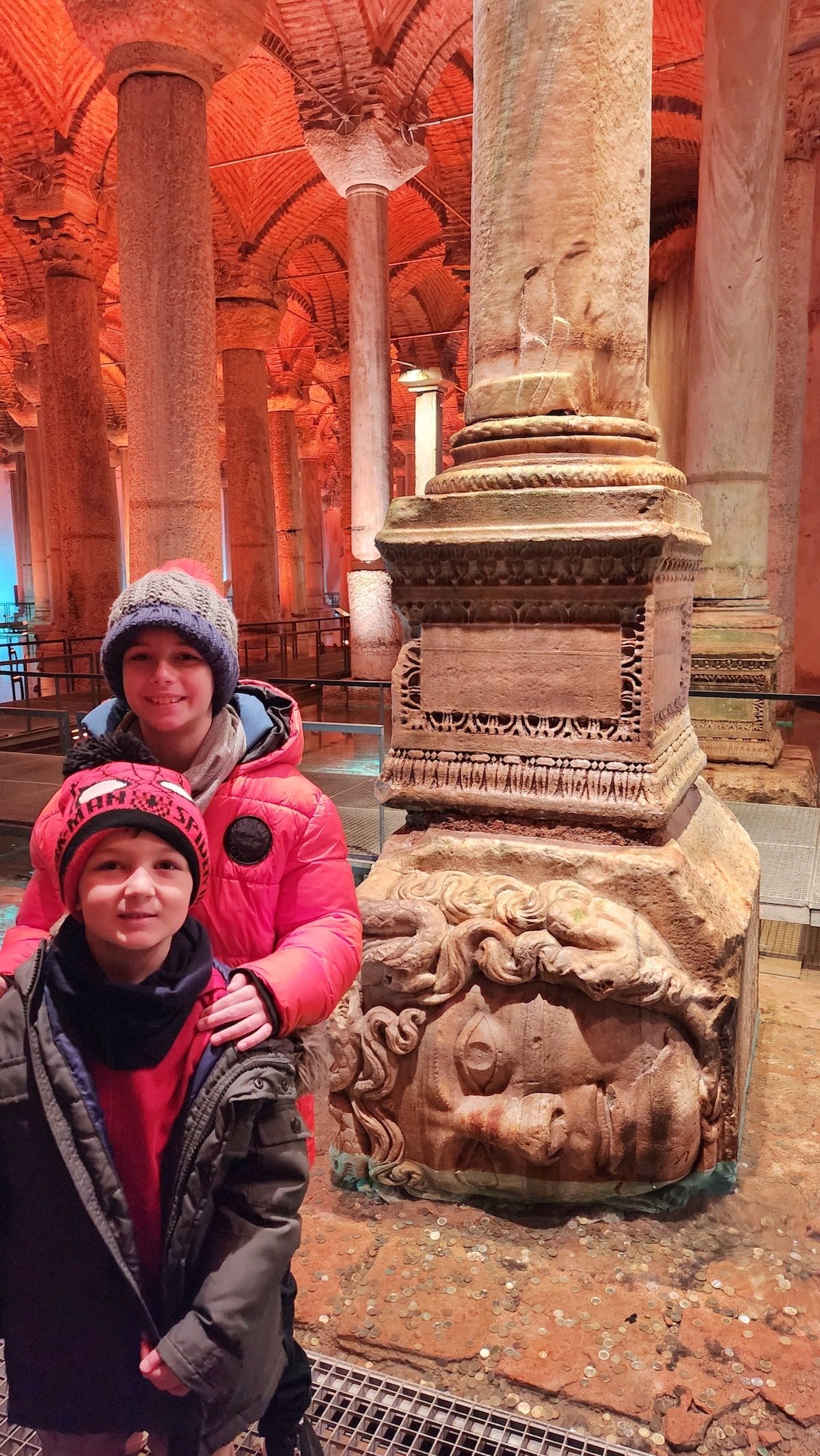
Welcome to the mysterious depths of Istanbul, where a subterranean wonder will leave you spellbound, hidden beneath the bustling streets. Behold the magnificent Basilica Cistern! Located right in the heart of Istanbul, Turkey, this ancient underground marvel is a captivating blend of history, architecture, and just a touch of magic.
Nestled beneath the lively streets of Sultanahmet Square, the Basilica Cistern is an architectural gem dating back to the Byzantine era. Imagine stepping into a secret underworld, where 336 columns rise from the watery depths like silent guardians of the past.
These columns, each with its own unique design, add a touch of grandeur to this underground palace. Oh, and keep an eye out for the legendary Medusa heads hiding among them; they’re bound to give you a chill or two!
As you descend into the dimly lit abyss, the atmosphere becomes delightfully eerie. Soft music trickles through the air, accompanied by the gentle echo of dripping water. It’s as if the cistern whispers tales of emperors, hidden treasures, and secret rendezvous from centuries ago. Take a moment to reflect on the tranquil beauty that surrounds you, and let your imagination run wild.
The Basilica Cistern is more than just an architectural masterpiece; it’s a testament to the city of Istanbul and its rich past. So, grab your explorer’s hat, get your camera ready, and get ready to embark on an unforgettable journey into the depths of history.
Whether you’re an adventurer, a history buff, or simply someone seeking an otherworldly experience, the Basilica Cistern is waiting to enchant you with its hidden wonders. Dare to delve into the unknown and discover the secrets that lie beneath Istanbul’s bustling surface.
13. Hagia Sophia Grand Mosque

Hagia Sophia is a former Byzantine church that was later converted into an Ottoman mosque. It is located in Istanbul, Türkiye, and was built in 537 AD by the Byzantine emperor Justinian I (527–565).
The building became a mosque upon its conquest by the Ottoman Empire, who abandoned it for another location when they conquered Constantinople in 1453. After being converted into an Orthodox Church by Patriarch Photios II (858-864), Hagia Sophia became a museum with worship practices resumed during major festivals such as Easter or Christmas breakers.
Note: As of January 15th, 2024, Hagia Sophia Grand Mosque has introduced a distinct policy for tourists and worshippers. If you’re visiting for cultural exploration, there’s now a 25 euro entry fee. This ticket grants you access to the gallery floor, where you can admire the sanctuary’s stunning Ottoman and Byzantine features, including the historic mosaics.
This new policy is all about balancing the preservation of this iconic site and enhancing the visitor experience, while ensuring that daily worship remains undisturbed.
Handy QR codes offer insights in 23 languages, making your visit both informative and enjoyable. For the latest updates and details, it’s a good idea to check out their official website.
14. Topkapi Palace

Topkapi Palace was the official residence of the Ottoman sultans for approximately 400 years. The palace complex is an excellent example of Ottoman architecture, and it contains many important artifacts, such as the treasury and harem, that are still on display today.
The palace itself was built by Sultan Suleiman I in 1550, but it was in 1620 when Topkapi gained its current name after being rebuilt by Selim II (who added more rooms to house his family). You can visit this magnificent site today if you want to learn more about how Turkish culture has evolved through history!
15. Blue Mosque – Sultan Ahmed Mosque
![]()
Ladies and gentlemen, behold the crown jewel of Istanbul’s skyline, the magnificent Blue Mosque, or as the locals lovingly call it, the Sultan Ahmed Mosque!
Situated in the heart of Sultanahmet Square, the Blue Mosque is one architectural masterpiece and is a sight to behold and an adventure waiting to unfold.
As you stroll through the bustling streets of Istanbul, your eyes will inevitably be drawn to the impressive domes and towering minarets of the Blue Mosque. It’s like a grand wizard’s castle from a storybook, only real and ready to whisk you away on a magical journey.
Step inside and prepare to have your breath stolen by a vibrant sea of blue. The mosque gets its name from the mesmerizing blue tiles that adorn its interior, casting an enchanting spell on all who enter. Imagine walking on a cloud of cerulean, with intricate patterns and delicate designs dancing beneath your feet.
But the real showstopper is the colossal dome that seems to touch the heavens. Its ethereal beauty will make you feel like you’ve stumbled into a celestial realm. The sunlight filtering through the stained glass windows creates a kaleidoscope of colors that bathe the prayer hall in a celestial glow.
The Blue Mosque is not just a place of worship; it’s a masterpiece that brings together art, history, and spirituality. So, come one, come all, and immerse yourself in the splendor of the Sultan Ahmed Mosque. Let its architectural marvels and captivating ambiance transport you to a world of wonder and leave you with memories that will forever be etched in the mosaic of your heart.
16. Sumela Monastery
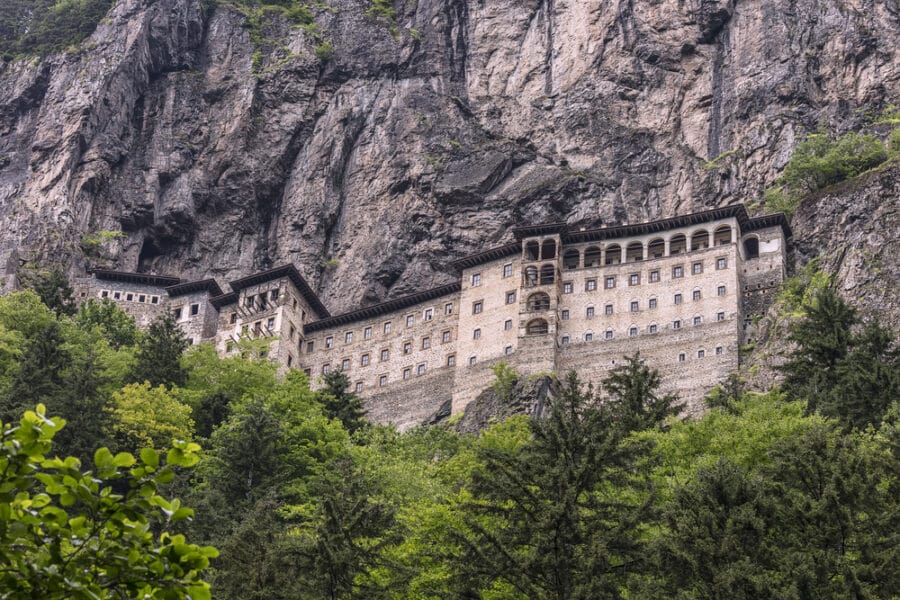
Sumela Monastery was built in Trabzon province, Turkey, in the 6th century. The monastery is the oldest monastery in Türkiye, with a history dating back to 525 AD when it was founded by Saint Gregory the Illuminator. It’s also considered one of Europe’s most important cultural references for Christianity due to its Christian architectural styles and its location on a cliff near the Black Sea, making it visible from afar even today!
17. Chora Church (Kariye Museum)
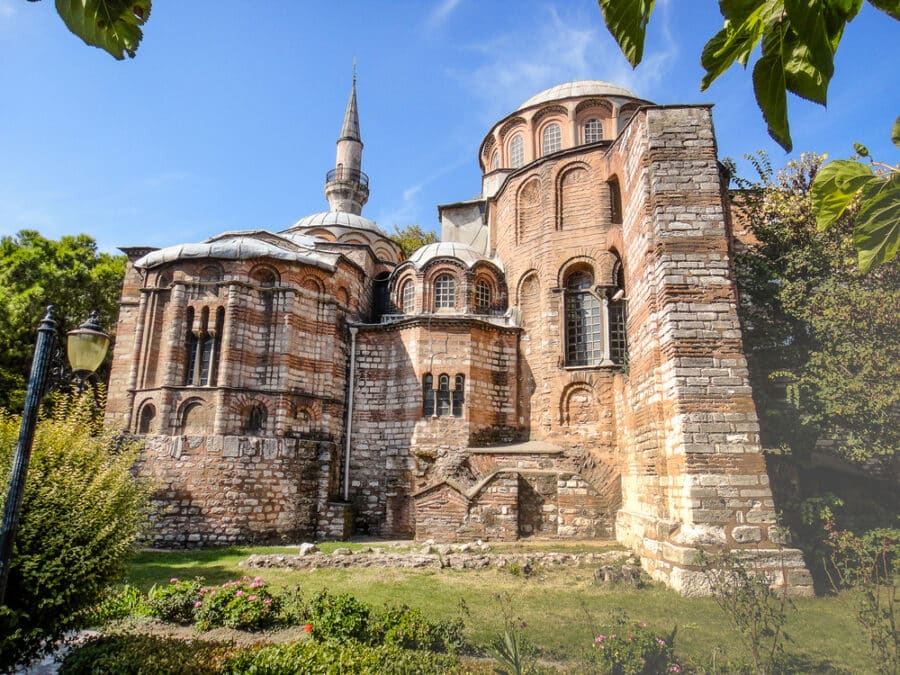
The Chora Church, also known as Kariye Museum, is a Byzantine church in Istanbul, Türkiye. It is situated on the grounds of the former Monastery of St. John the Baptist, and it’s believed to have been built during the 11th century.
The history of this building goes back to the 4th century when Emperor Constantine I founded a monastery at his palace on Palaiokastritsa hill, which was later renamed Chrysopolis (Holy City).
The church was converted into a mosque during Ottoman rule after being abandoned between 1453-1566 due to earthquakes and fires set by invading armies who used its stone walls as fortifications against Constantinople’s defenders led by Mehmed II, who conquered it twice before defeating it permanently in 1453 CE when he captured Constantinople while still under siege from Christian forces led by Giovanni Giustiniani who had taken control over much of Europe including Italy where Giustiniani died fighting off Ottomans outside Florence just days before Constantinople fell back into Islamic hands again at 1512 CE.
18. Grand Bazaar, Istanbul
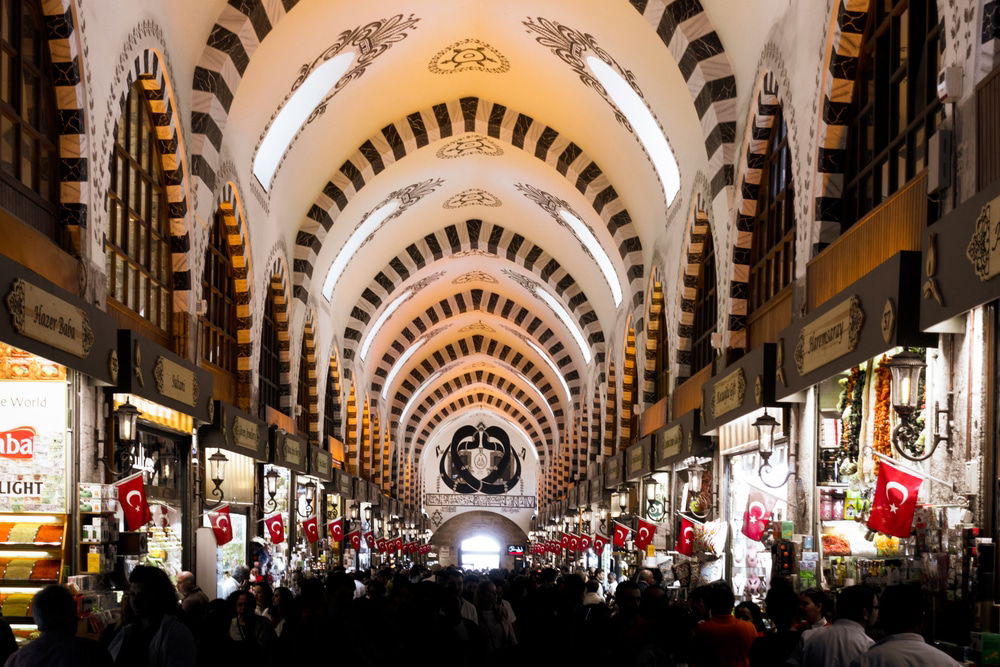
Welcome to shopaholic paradise, the Grand Bazaar in Istanbul, Turkey! Brace yourself for a vibrant maze of colors, sounds, and tantalizing treasures. Nestled in the heart of the city, this bustling marketplace is a shopaholic’s dream come true.
As you step into this retail wonderland, prepare to be swept away by a whirlwind of excitement. The Grand Bazaar is a labyrinth of narrow streets adorned with an endless array of shops, stalls, and hidden gems. You’ll find yourself lost in a treasure trove of delights, from vibrant textiles to gleaming jewelry, aromatic spices, and intricately crafted ceramics.
But it’s not just the merchandise that makes the Grand Bazaar special; it’s the vibrant atmosphere. Imagine the chorus of merchants haggling and beckoning you to explore their wares. The scents of exotic spices wafting through the air, and the energetic buzz of shoppers eager to find their perfect bargain. It’s a symphony of commerce that will awaken all your senses.
So, embrace your inner shopaholic, bring your bargaining skills, and get ready to indulge in retail therapy like never before. The Grand Bazaar is waiting to whisk you away on a shopping adventure you’ll never forget. Just remember to pack an extra suitcase for all the treasures you’ll bring home!
19. Mount Nemrut, Adiyaman
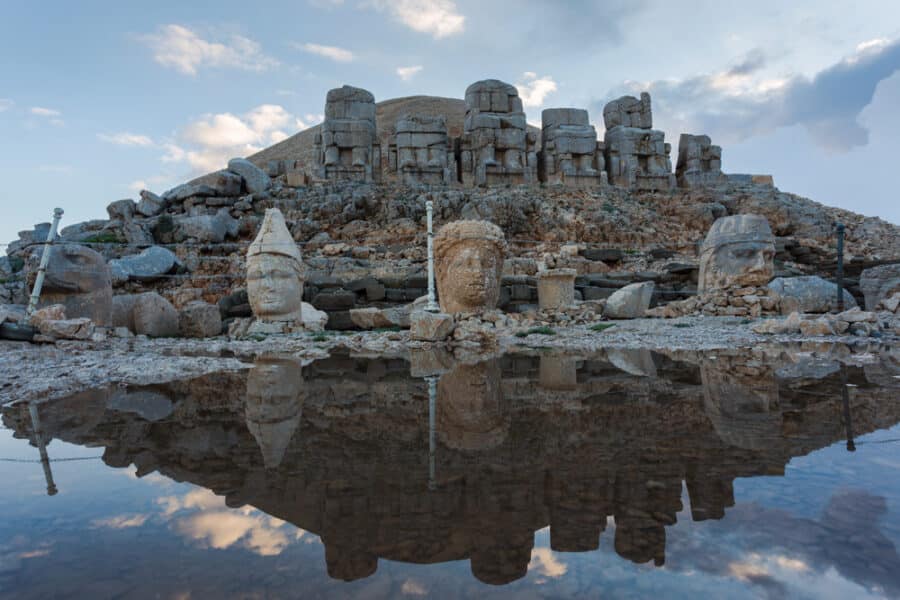
This particular landmark is very off the beaten track for most tourists visiting Türkiye for a beach break, but if you want to stretch your legs and see something truly magnificent, it’s more than worth the effort.
Mount Nemrut is located in Adiyaman, in south-eastern Turkey, not too far from the Syrian border – do not let that put you off as this is still a popular tourist destination and, as such, safe to visit. The mountain has stunning views, but that’s not what it is famous for.
It’s most famous for its enormous carved stone heads that sit almost randomly at the top of the mountain and on the path leading to the summit. Nobody is 100% sure how they got there, but the theory is that they were put there to show the power that Alexander I yielded back in the day.
You can see this fantastic and quite jaw-dropping sight at any time of the year; indeed, it is one of those unique places to visit in Türkiye, but this part of the country does have freezing temperatures and a lot of snow during the winter. So, between April and October is the best time to go.
20. Canakkale & The Monument
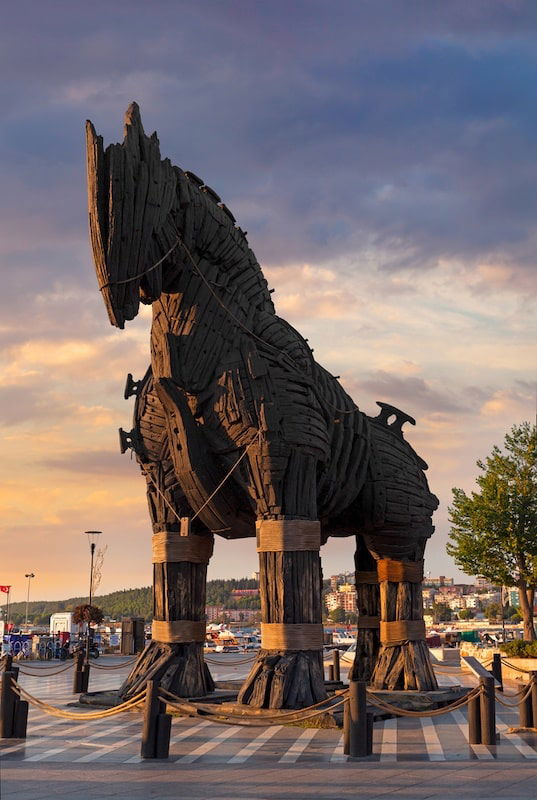
The seaport of Canakkale is located on the Asian coast of Turkey’s Dardanelles strait, in a region rich in ancient sites and modern history, as well as myths and legends that have stood the test of time.
In reality, many of the sights and activities in Canakkale are linked to the stories that have made the city famous. What is now Canakkale, first occupied about 6,000 years ago during the Copper Age, has seen numerous invading armies pass through the region and been ruled by many states.
The legendary Trojan Wars and the Gallipoli Campaign, the most well-known battle between the Allied Forces and the Ottomans in World War I, both took place nearby, as did the epic love story Hero and Leander from Greek mythology.
The best activities to do here are going on a historical tour in Gallipoli, visiting the many museums inside the city, admiring the huge castles, and paying your respects at the monuments for the martyrs of the deadly First World War. This is easily one of the most incredible hidden gems in Turkey.
21. Anıtkabir, Ankara
This isn’t just any mausoleum; it’s the resting place of Mustafa Kemal Atatürk, Turkey’s founding father. Located in Ankara, Anıtkabir is a symbol of Turkish pride and history. Its architecture is grand, and the changing of the guards’ ceremony is something to watch. Ankara is easy to reach by train, bus, or plane from major Turkish cities.
22. Aspendos
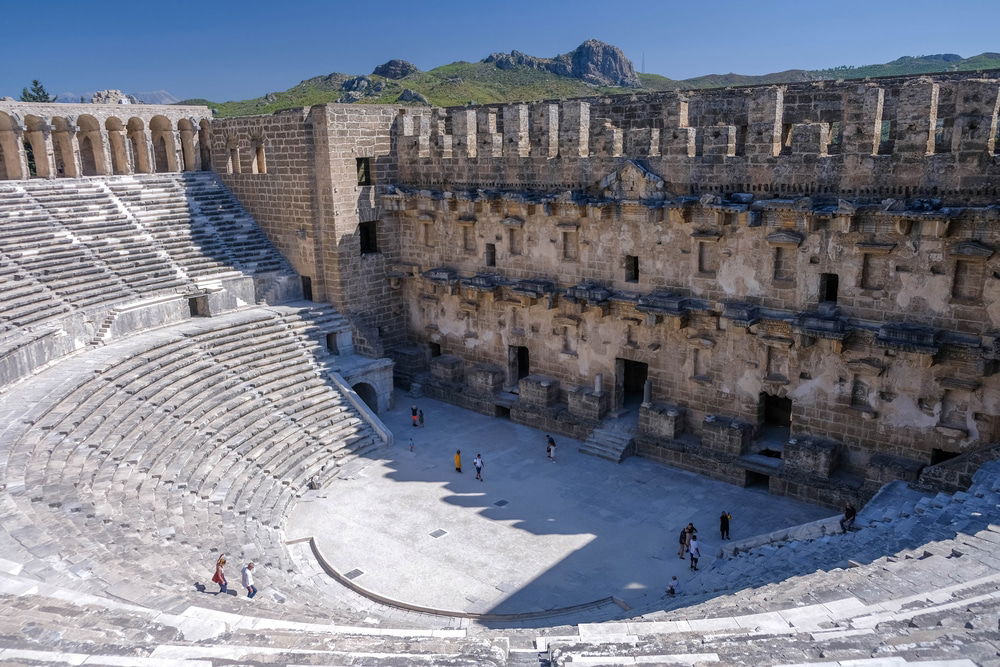
Imagine a theater so well-preserved that it’s still used for performances today. That’s Aspendos for you. Near Antalya, this Roman theater is a testament to ancient engineering. It’s a bit off the beaten path, but a drive or a guided tour from Antalya will get you there easily.
23. Selimiye Mosque, Edirne
This mosque is a masterpiece by the famous architect Mimar Sinan. Located in Edirne, it’s known for its stunning dome and elegant minarets. The mosque’s interior is just as impressive as its exterior. Edirne is reachable by bus or train from Istanbul, making it a great day trip.
24. House Of The Virgin Mary

Near Ephesus and Selçuk, this is a sacred site believed to be where Mary spent her last days. It’s a place of pilgrimage and peace, surrounded by nature. Selçuk is easily accessible from Izmir by train or bus.
25. Rumi Mevlana Mausoleum, Konya
Home to the tomb of Rumi, a famous Sufi mystic, this mausoleum in Konya is both a museum and a place of pilgrimage. The green dome and tranquil atmosphere make it a serene experience. Konya is accessible by bus or high-speed train from major cities like Ankara. While there, book tickets to see Turkey’s most famous Whirling Dervish.
26. Ancient Tombs Of Dalyan
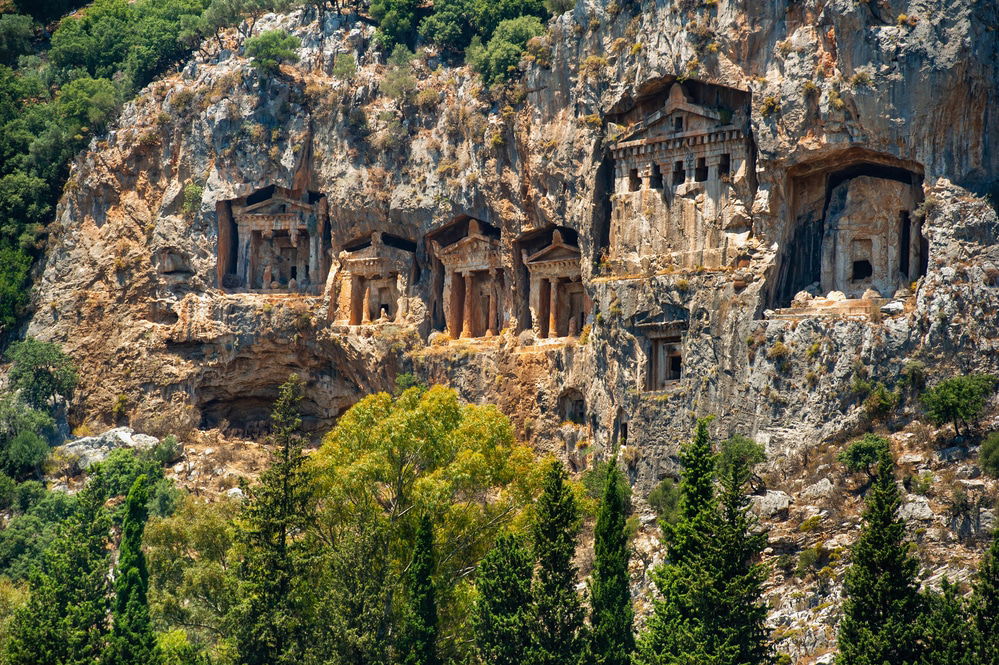
These rock-cut tombs carved into cliffs are a sight to see in Dalyan. They date back to the Lycian period and are best viewed from a boat on the Dalyan River. Dalyan is a cozy town, reachable by bus from places like Marmaris or Fethiye.

27. Ruins Of The Mausoleum Of Halicarnassus, Bodrum
In Bodrum, you’ll find the remains of one of the Seven Wonders of the Ancient World. Although not much is left of the Mausoleum, the site’s history is captivating. Bodrum is a popular destination, reachable by bus, car, or plane.
28. Galata Tower
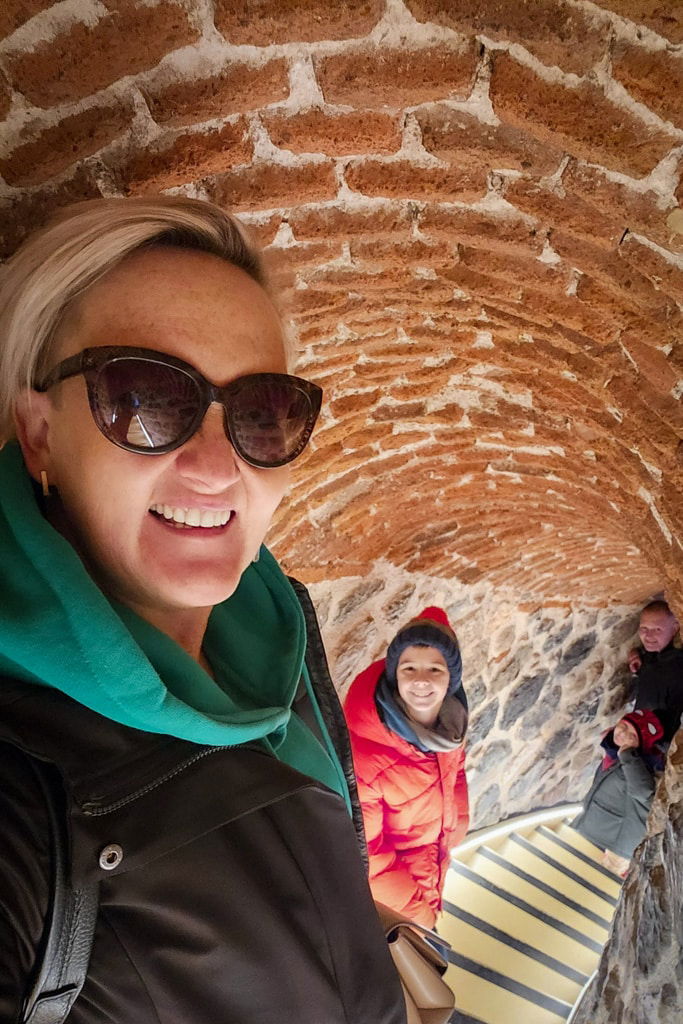
Galata Tower isn’t just a tower; it’s a symbol of Istanbul’s rich history. Standing tall in the Galata district, this medieval stone tower offers stunning panoramic views of the city and the Bosphorus. It’s a must-see for anyone who loves a good view. Getting there is easy, just a short walk from the Şişhane metro station or a fun ride on the historic Tünel funicular if you’re coming from Karaköy.
29. The Walls Of Constantinople
The Walls of Constantinople are not just walls; they’re a testament to Istanbul’s (formerly Constantinople) historical significance as a fortified city. These ancient walls have withstood sieges and time, and walking along them is like a journey through history. You can start your exploration from the Yedikule Fortress, reachable by train or bus from the city center.
30. Dolmabahçe Palace
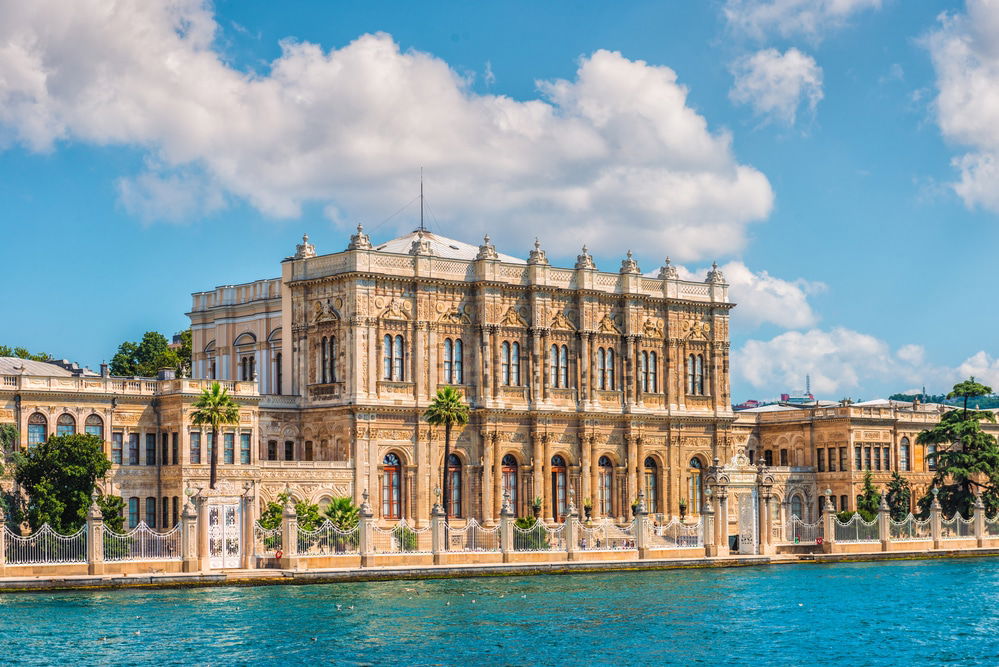
Imagine a palace that blends traditional Ottoman architecture with European styles, and you have Dolmabahçe Palace. This stunning palace along the Bosphorus in Istanbul is a feast for the eyes, with its luxurious interior and ornate design. It’s where history and opulence meet. You can get there easily by tram or bus, disembarking at the Kabataş stop.
31. Carian Rock Tombs Of The Dalyan Delta
The Carian Rock Tombs in the Dalyan Delta are ancient and majestic, carved into cliffs. They tell tales of an ancient civilization. The best view is from a boat on the Dalyan River, easily reachable from Dalyan town.
Brands We Use And Trust
Famous Turkey Landmarks Of The Ancient City Kind
32. Ancient City Of Ephesus
Ephesus was one of the largest cities of the ancient world. It was a major center of early Christianity and is now considered a World Heritage Site. The ruins are located in Izmir province, Türkiye.
This once-ancient Greek city was founded by Greeks who came from Ionia on the west coast of Asia Minor (present-day Türkiye). Greek settlers colonized it from Miletus, who migrated there around 600 BCE. During its peak period between 350 BCE and 300 CE, it had an estimated population of over 100,000 people—about four times that of Athens at its height!
As you wander the marble-columned roads, don’t miss the Library of Celsus – it was one of my favorite sites in Turkey. Other sites not miss are:
- Various Baths of Ephesus
- Ephesus Great Theater
- Prytaneion
- Temple of Hadrian
- Temple of Artemis
- Terraced Houses
- Hercules Gate
- Winged Nike
33. Ani Ruins

Get ready for a time-traveling adventure in the wild landscapes of Turkey! Tucked away in the eastern part of the country lies the mystical UNESCO-listed Ani Ruins, a ghostly city frozen in time. Picture yourself as an archaeologist-explorer as you journey near the Armenian border to uncover this hidden gem.
Perched on a windswept plateau overlooking the Akhurian River, the Ani Ruins are a hauntingly beautiful testament to a bygone era. Once a bustling medieval city, it now stands in glorious ruins, offering a glimpse into its former grandeur.
As you wander through the ancient streets, among crumbling churches and majestic citadels, you can almost hear whispers of forgotten tales carried by the wind.
Prepare to be captivated by the architectural marvels that dot the landscape. Marvel at the ornate stone carvings that have stood the test of time and the intricate details that tell stories of a rich and diverse history. The vastness of the site and its mystical aura will transport you to a world where empires rise and fall, leaving behind echoes of their former glory.
34. Ancient City Of Hierapolis
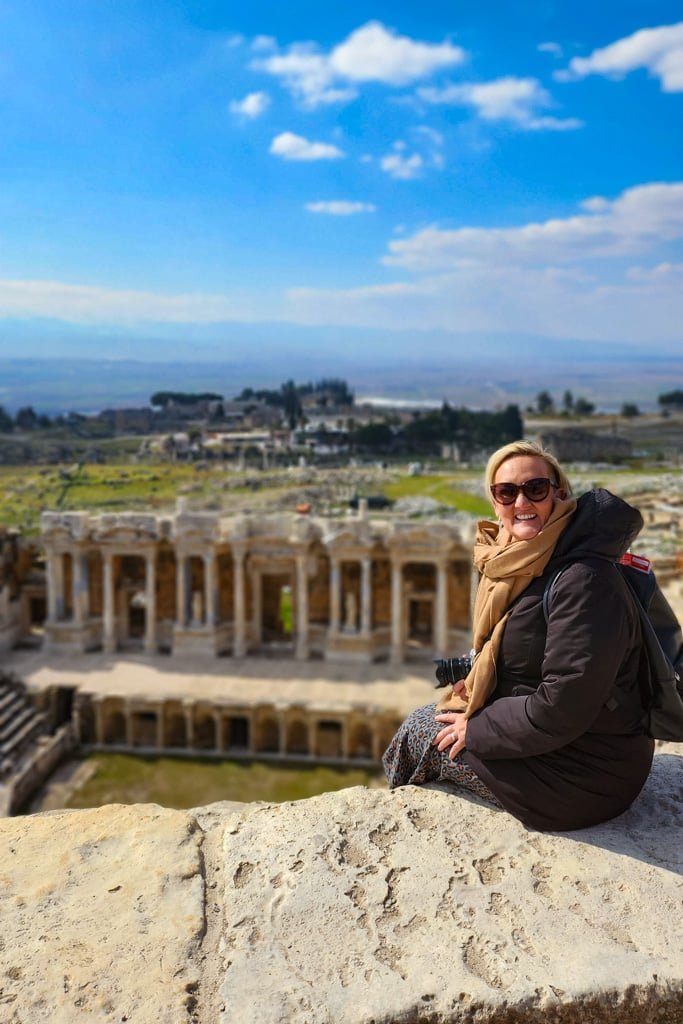
Hierapolis was an important religious and cultural site for the ancient civilizations in southwestern Turkey.
Experts believe the area was a cult center dedicated to Cybele before the first Greek colony was founded in the area—the first known settlements in Hierapolis date back to the Iron Age.
A Phrygian temple of the mother Goddess Cybele was built in the 7th century BCE. Although the local communities used the temple to worship their ancient gods, once the Greeks arrived, the local culture and religious cults were assimilated into the Greek ones. Under the Phrygian rule, the area was associated with the underworld; this association continued during the subsequent Greek and Roman period. Greeks associated the temple of Hierapolis with Hades, or Pluton, in Roman mythology.
The settlement in the area became a city under the Seleucid Empire in the 2nd century BCE. Emperor Antiochus the Great populated the area with 2,000 Jewish families, which caused a mass migration of Jews to Hierapolis.
During the first century CE, the area rapidly converted to Christianity, and a church was founded in Hierapolis. However, this era was also marked by major earthquakes, the last of which occurred in 60 CE and destroyed the entirety of Hierapolis. Nevertheless, the city was rebuilt later.
Until the 12th century, the city was ruled by the Byzantine Empire and was an important religious center with numerous basilicas and the tomb of Paul the Apostle. In the early 12th century, Seljuk Turks briefly controlled Hierapolis and fell to the Crusaders in 1190. A short time after the Crusaders conquered the area, Hierapolis was abandoned.
35. Myra Ruins
Picture strolling through an ancient Lycian city, and you’re at the Myra Ruins in Antalya. Known for its impressive rock-cut tombs and a large Roman theater, Myra offers a peek into the past. It’s like stepping into a history book, where each stone tells a story. To get there, you can take a bus or drive from Antalya, and it’s a fantastic stop for history buffs.
36. The City Of Troy
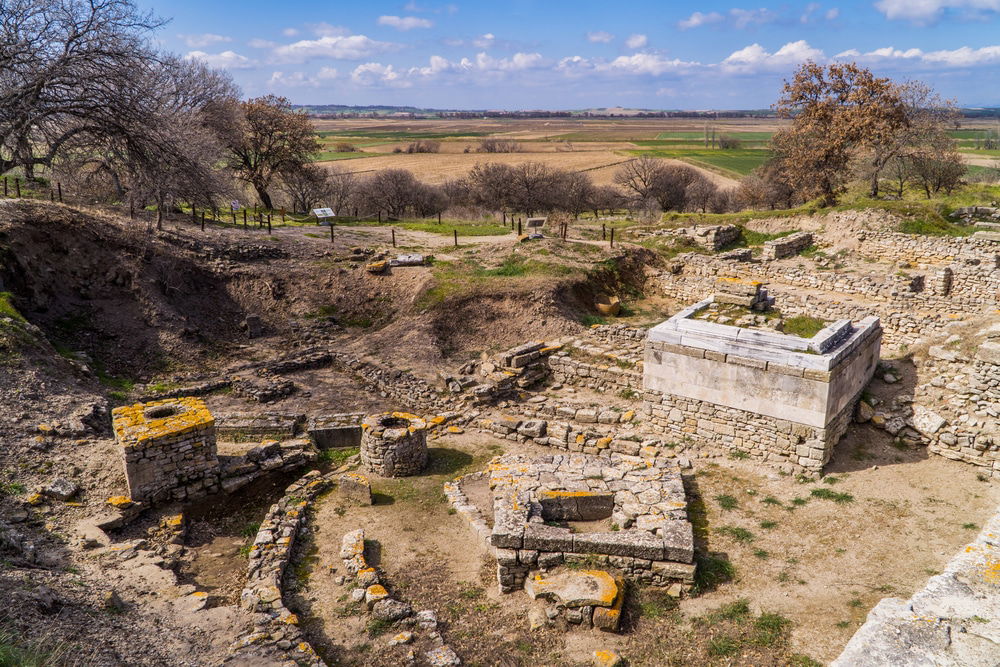
Yes, the legendary city from Homer’s tales is real, and it’s in northwestern Turkey near Çanakkale. Famous for the Trojan War, it’s a site where mythology meets history. Exploring Troy, you’ll see remnants from various periods, showing how civilizations stacked upon each other. Hop on a bus or drive from Çanakkale, and you’re on your way to walking the same ground as Achilles and Hector.
37. Hattusha
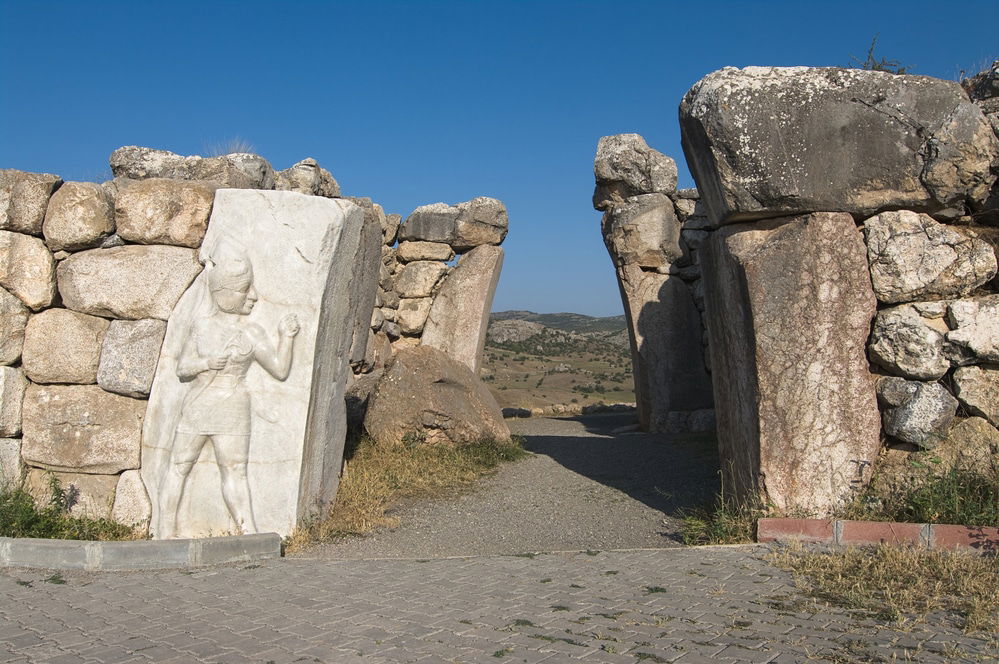
This was once the capital of the Hittite Empire, now a UNESCO World Heritage site near Çorum. The ancient city’s ruins, including impressive fortifications and temple remains, are fascinating. You’ll need a car or a guided tour from Ankara or Çorum to explore this off-the-beaten-path gem.
38. Ruins Of Aphrodisias
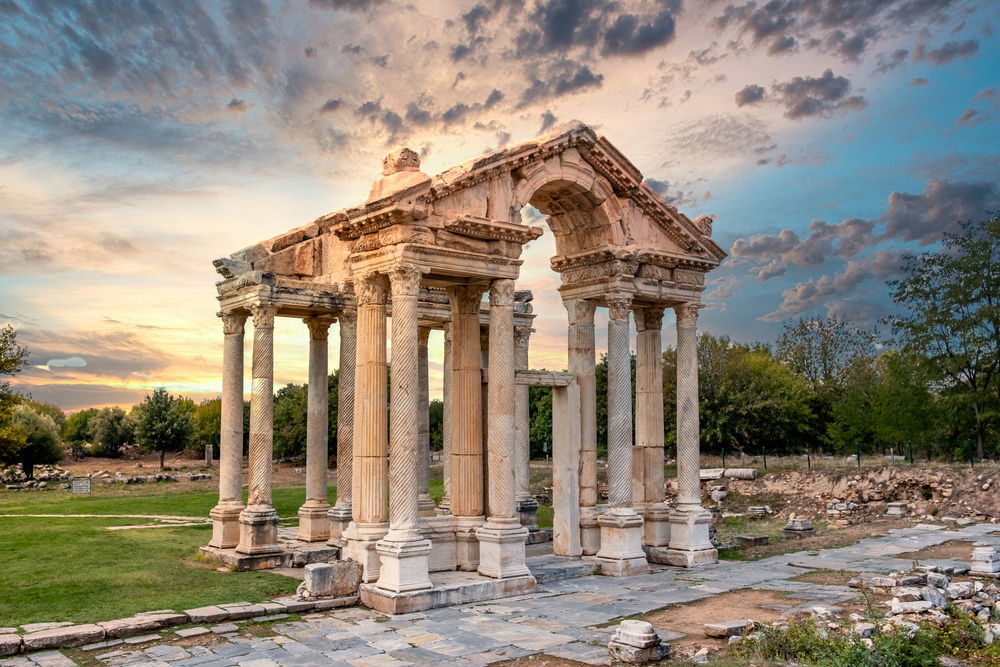
This ancient Greco-Roman city near Aydın is famous for its Temple of Aphrodite. The on-site museum showcasing sculptures is a bonus. The best way to visit is by car or with a tour from nearby towns like Denizli or Aydın.
Move This Adventure To Your Inbox & Get An Instant Freebie

No spam. Unsubscribe at any time.
Culinary Landmarks In Turkey
39. Gaziantep
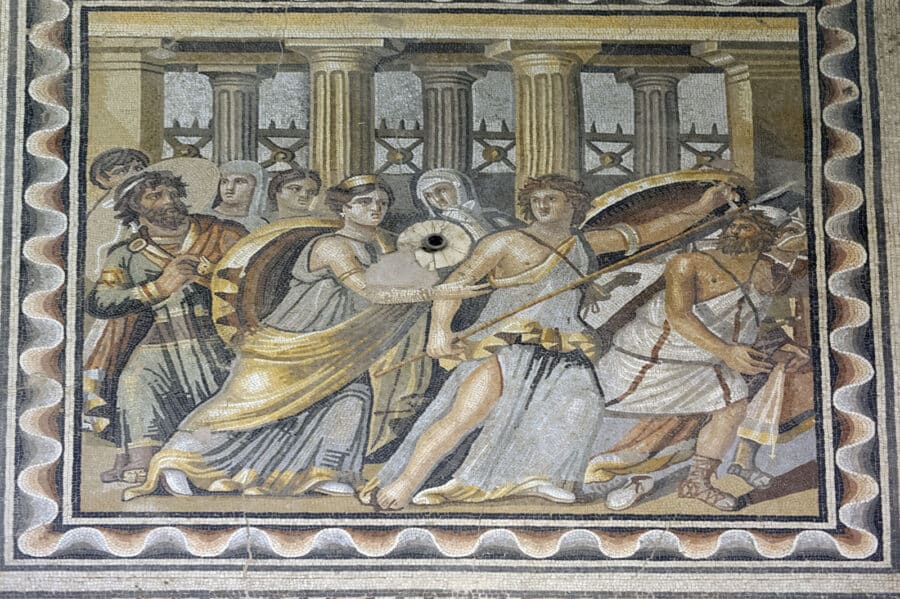
The Baklava Center in Turkey is well-known among foodies. The sweet treats of Gaziantep are famous throughout the world. Beyond the sugar rush, there’s a lot to explore.
The Gaziantep Zeugma Mosaic Museum is a popular site. The museum houses one of the world’s most important collections of Roman-era mosaic floor art, all of which were rescued from the nearby Belkis-Zeugma archaeological site before it was submerged under the Birecik Dam’s waters.
Wandering the old town area of Gaziantep is one of the city’s true pleasures. Its numerous baklava shops and compact bazaar alleys, which are packed with traditional craftwork stores and historic coffee houses, could easily take up an entire day of your time. So, if you’re planning a culinary tour of Turkey, Gaziantep is absolutely one of the towns in Turkey to visit.
What Else About Famous Places?
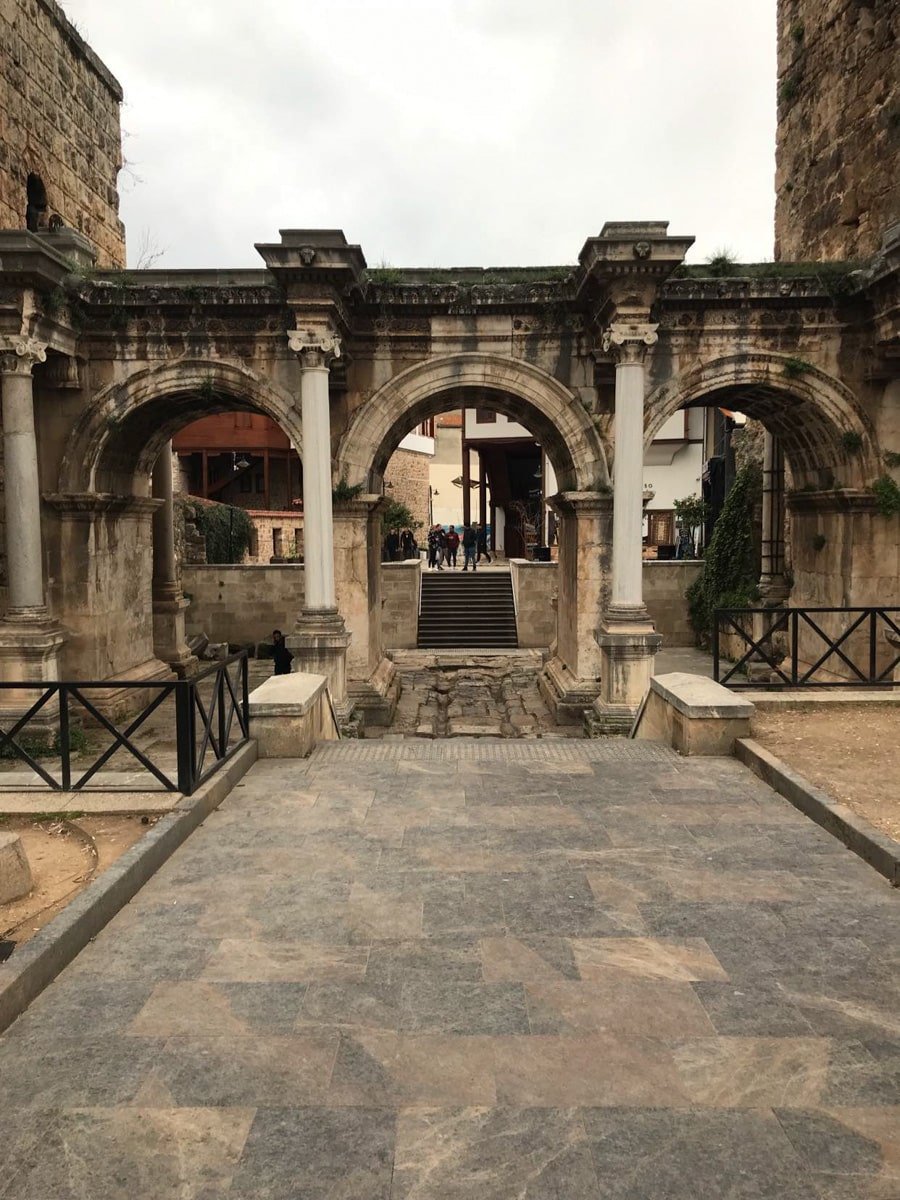
Turkey is a country with a rich history and unmissable historical sites worth visiting. We could add many more landmarks in Türkiye to this list!
Ohh, Türkiye has a lot of sights to see and culture to absorb. Türkiye is a land of many different cultures and landscapes; from the city sights of Istanbul to the beaches of Antalya, there is much to see and do in this beautiful country. So tell us, of these most famous Turkish landmarks, which iconic landmark will you head to first?
Türkiye is a land of contrasts. The country is home to some of the most stunning natural wonders in the world and bustling metropolises full of culture and history. With so much to see and do, it can take time to figure out where to start.
That’s why we’ve put together so many guides on how to make the most of your time in Türkiye for you below.
- Ankara, Turkey
- One Of The Most Beautiful Mosques In The World
- Best Cities In Turkey
- Best Places To Visit In Türkiye
- Beyoglu Or Sultanahmet
- Bodrum Or Antalya
- Bosphorus Strait View Hotels
- Day Trips From Antalya
- Day Trips From Istanbul
- Getting Around Istanbul
- Hotels In Taksim Square
- How To Get From Ankara To Istanbul
- How To Get From Istanbul To Sofia
- Istanbul Nightlife
- Istanbul Or Cappadocia
- Istanbul To Izmir
- Istanbul Tourist Scams
- Marmaris Turkey
- Medical Tourism In Istanbul
- Palaces In Istanbul
- Pamukkale Hot Springs
- Romantic Places In Istanbul
- Sandy Beaches In Türkiye
- Short Day Trips From Istanbul
- Solo In Turkey
- Things To Do In Izmir
- Turkish Hammam Spa
- Turkish Souvenirs
- Vegan Food In Türkiye
- Visit Gallipoli
Whether you’re planning a short trip or a more extended vacation, following our tips will help you make the most of your time in Turkey.
- The Do’s And Don’ts Of Visiting Türkiye
- Best Places To Visit In Turkey For Every Type Of Traveler
- How To Get From Istanbul To Cappadocia
- Most Beautiful Cities In Turkey
- Interesting Customs & Etiquette In Turkey
- Best Nightlife In Istanbul
- Day Trips To Take From Istanbul
- Greek Island Day Trip From Southern Turkey
- Best Beaches To Visit In Türkiye
- Ephesus, UNESCO Site
- How To Get From Pamukkale To Cappadocia
- Best Islands In Turkey To Visit This Summer
- Things To Do In Cappadocia
- Honeymoons In Türkiye – Where To Go & What To See
- Reasons To Skip Turkey (But You’ll Regret It)
- Non-Touristy Places In Turkey Perfect For Instagram



